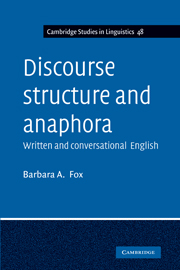
-
Select format
-
- Publisher:
- Cambridge University Press
- Publication date:
- 01 June 2011
- 08 October 1987
- ISBN:
- 9780511627767
- 9780521439909
- Dimensions:
- Weight & Pages:
- Dimensions:
- (228 x 152 mm)
- Weight & Pages:
- 0.31kg, 184 Pages
You may already have access via personal or institutional login
Book description
Barbara Fox's thoughtful study examines the use of anaphora in both written and spoken discourse. Any treatment of anaphora must consider the hierarchical of its source texts-type. Texts may be produced and heard or read linearly, but they are designed and understood hierarchically. Discourse Structure and Anaphora goes beyond the information processing concerns of cognitive science to assess the critical role played in all text-types by social, interactional and affective factors. It also considers the fact that texts are organised by socially accepted conventions. Using conversation analysis and rhetorical structure analysis, this book looks at the distribution of pronouns and full noun phrases in three different genres of English, taking data from naturally occurring face-to-face and telephone conversations, small newspaper and magazine articles and a psychoanalytic biography.
Reviews
"...is a tightly argued, well-documented, innovative reformulation of the theory of anaphora that should have an impact on thinking about anaphora in discourse." Studies in Second Language Learning
Contents
Metrics
Full text views
Full text views help Loading metrics...
Loading metrics...
* Views captured on Cambridge Core between #date#. This data will be updated every 24 hours.
Usage data cannot currently be displayed.
Accessibility standard: Unknown
Why this information is here
This section outlines the accessibility features of this content - including support for screen readers, full keyboard navigation and high-contrast display options. This may not be relevant for you.
Accessibility Information
Accessibility compliance for the PDF of this book is currently unknown and may be updated in the future.


